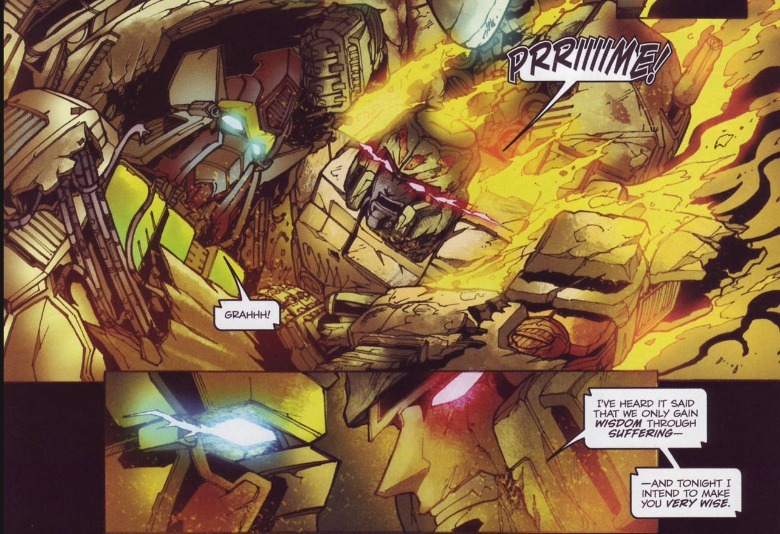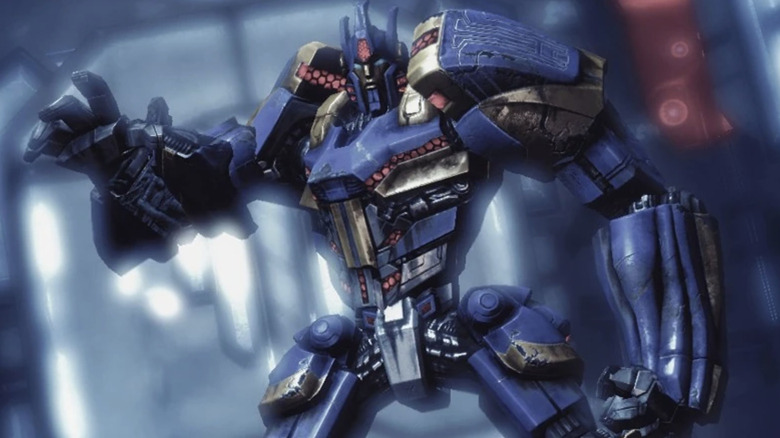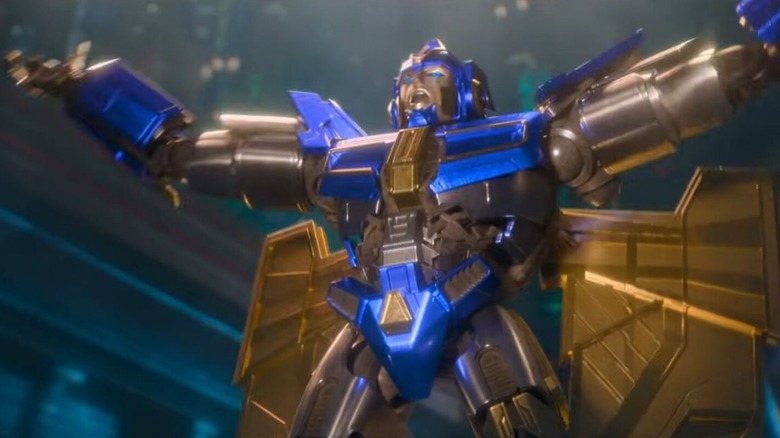Transformers One Continues A Franchise Trend With Sentinel Prime
Spoilers for “Transformers One” follow.
The ultimate villain of “Transformers One” winds up being, of course, Megatron (voiced by Brian Tyree Henry). Initially a harmless miner named D-16, the future Megatron’s belligerence sparks a schism with his best friend, Orion Pax (Chris Hemsworth). By the film’s ending, Orion has ascended to become Optimus Prime, while Megatron is on track to become his infamous Decepticon warlord self.
Since “Transformers One” is about Megatron’s fall from decent bot to tyrant, most of the film features a different villain. This antagonist is the catalyst for both Optimus Prime and Megatron’s rise. Who is it? Sentinel Prime (Jon Hamm), ruler of planet Cybertron and a great big fraud!
Sentinel plays the part of a benevolent leader making tough decisions for an energy-starved society, who nonetheless finds time to give his people bread and circuses. But he sits at the head of a fierce caste system in which the robots who can transform have more rights than the miners who can’t. Every problem Cybertron faces is Sentinel’s doing, too. The planet’s vanishing energy supply? Sentinel sold out to the alien Quintessons and is paying them off with the Energon that the miners harvest. The disappeared Matrix of Leadership? It sensed Sentinel was an unworthy Prime and refused to let itself be his.
When our leads learn the truth about Sentinel, it shatters them — and then reassembles them with new drive. Megatron is out for revenge, while Optimus Prime becomes the hero Cybertron needed all along. Sentinel Prime’s villainous role in “Transformers One” is nothing new. It’s become a franchise tradition to depict Optimus’ predecessor as not a great Prime he must live up to, but a corrupt one whose legacy he must redeem.
The Transformers origins of Sentinel Prime, explained
Sentinel Prime is a creation of the prolific “Transformers” comic writer Simon Furman, who first wrote UK-exclusive issues of the Marvel “Transformers” comic during the 1980s. Furman’s “Transformers” #150 depicted a flashback of Optimus Prime receiving the Matrix of Leadership from a dying, golden-colored Autobot. “Transformers” #65 (#290-293 by British numbering) then listed every past Transformer to have held the Matrix of Leadership. “Sentinel Prime” preceded Optimus Prime in this list, retroactively naming the yellow robot from #150.
Furman then reused the name “Sentinel Prime” for his “Transformers” mini-series “The War Within,” published by Dreamwave Productions and set entirely on Cybertron before the Transformers came to Earth. Sentinel is killed off-panel by Megatron and his death prompts the ascension of Optimus Prime.
Writer Eric Holmes later pitched a “Transformers” comic chronicling the rise of Megatron and the Decepticons to Dreamwave. After Dreamwave went bankrupt in 2005 (while neglecting to pay writers and artists doing work for the company), Holmes took his pitch to IDW Publishing, the next holders of the “Transformers” license, who turned it into the four issue mini-series “Megatron Origin” in 2007 (written by Holmes, drawn by Alex Milne).
Megatron goes from miner to gladiator to revolutionary over the course of “Origin.” Cybertron is a starkly divided society and the Decepticons form out of the forgotten dregs to overthrow the rapacious elites. The Autobots, initially depicted as Cybertron’s security force (read: cops), are led by Sentinel and spend the mini-series trying to crack down on this nascent rebellion. In issue #4, Sentinel fights Megatron bot-to-bot — and loses. The final panel of the series is Megatron sitting in a throne made out of Sentinel’s broken armor.
“Megatron Origin” has too much story for its allotted four issues; the narrative beats make sense, but they unfold like a beat list. Megatron undeniably changes, but you don’t understand why. The comic could’ve sorely benefited from more issues and an internal monologue for its lead.
Sentinel is similarly thinly-sketched. He seems disillusioned with Cybertron’s corrupt Senate and disinterested in his duties (pawning them off to his Autobot lieutenant Prowl), but then he comes down hard on Megatron. Is he a burnt out idealist or a law and order goose-stepper? Later “Transformers” writer James Roberts would fill in some of the gaps left by “Megatron Origin” and reveal Sentinel was indeed quite corrupt.
Brian Ruckley, who later wrote an ongoing “Transformers” series set in the lead-up to the war, took a different route. His Sentinel Prime was not evil, but ultimately unable to stop the Decepticons from rising or assassinating him. Ruckley’s incompetent but well-meaning Sentinel stands out as one of the more positive depictions — which says a lot about how vile the others are.
Sentinel Prime in Transformers Animated
“Transformers Animated” played around with franchise conventions. This Optimus Prime (David Kaye) was a young and inexperienced leader. He wasn’t commander of all Autobots, just a small squad of rookies. “Prime” was just another rank in the Autobot military in “Animated,” meaning Optimus wasn’t the only Prime out there.
The series’ production bible mentions using another Prime as a rival character for Optimus, specifically suggesting Rodimus Prime (who briefly replaced Optimus after his death in the 1986 “The Transformers: The Movie”). The series ultimately used Sentinel Prime instead, apparently because Hasbro didn’t want Rodimus’ good name attached to such an unlikable character. “Animated” Sentinel Prime wasn’t a villain, but he was a complete a-hole who caused as many problems for Optimus and co. as the Decepticons did.
Voiced by Townsend Coleman, Sentinel’s design homaged his actor’s previous role as “The Tick,” with a huge chin and blue color scheme. His personality though, was reportedly inspired by Frank Burns (Larry Linville) from “M*A*S*H” — an arrogant, egomaniacal and blisteringly incompetent officer who was impossible to like and only made soldiers’ lives harder.
“Transformers Animated” ended before Sentinel could get any true comeuppance (or become even worse), but the show often took him down a down a peg as payback for being so insufferable.
Sentinel (Zeta) Prime in Transformers: War for Cybertron
The 2010 video game “Transformers: War for Cybertron” was another robots-only prequel, like the previous “War Within” and the future “Transformers One.” Produced by High Moon Studios, “War for Cybertron” was set during the final days of the war. In the game, Optimus becomes a Prime after Megatron kills the Autobots’ original leader, Zeta Prime.
“Zeta Prime” comes from the IDW “Transformers” comics, where he was a separate individual from Sentinel. I’m not sure why High Moon Studios went with this name, especially since concept art for the character is labeled “Sentinel Prime.” To smooth this over, supplementary material retconned the character’s name as “Sentinel Zeta Prime.”
Most “Transformers” video games before this had dual campaigns: one where you played as the Autobots, one where you played as the Decepticons. The campaigns’ mutually exclusive stories would see one faction triumph over the other. “War For Cybertron” stood out from the rest with a single campaign flowing across one timeline. In the first five levels, you play as the Decepticons and conquer Cybertron. Then, halfway through the game, you switch over to the Autobots and undo the damage your player characters inflicted in the first half.
This results in an interesting perspective on Sentinel/Zeta (voiced by Troy Baker). He’s not a bad guy, but you first meet him while you’re playing as the Decepticons — ergo, he is an antagonist and a challenge you must overcome. This is similar to the earlier “Megatron Origin,” which revised the Decepticons as a needed rebellion and the Autobots as enforcers of a corrupt status quo.
Sentinel Prime in Transformers: Dark of the Moon
The most famous version of Sentinel Prime is his appearance as the surprise villain in “Transformers: Dark of the Moon,” director Michael Bay’s third film in the series. Voiced by the late, great Leonard Nimoy, Sentinel stands as the best Bayformers villain. Low bar, I know, but he’s still the only one with anything inkling of pathos or character depth. (His sick design doesn’t hurt either.)
This Sentinel wasn’t just Optimus Prime’s predecessor. He was Optimus’ mentor, the one who taught him the words “Freedom is the right of all sentient beings.” But as civil war laid Sentinel’s beloved Cybertron to ruin, he discarded those ideals. He made a secret pact with Megatron, agreeing to conquer Earth together then harvest its resources and enslave its people to rebuild Cybertron.
Sentinel left Cybertron at the end of the war aboard the starship Ark. He was supposedly carrying the Autobots’ final hope, but was really setting out to sow the seeds of Earth’s ultimate doom. A stray missile hit left the Ark lost in space, until it crashed on Earth’s moon. When Optimus and the Autobots learn the ship’s location, they rescue and revive Sentinel, unaware of his true plans until he kills Ironhide (Jess Harnell).
It’s suggested the betrayal pains Sentinel as much as it does Optimus. Unlike his student, though, Sentinel values the Transformers’ future more than he does humanity’s.
Sentinel Prime in Transformers One
That brings us back to the Sentinel Prime of “Transformers One.” Director Josh Cooley clearly did his “Transformers” homework and the portrayal of Sentinel shows that. His design is a hybrid of past looks. This Sentinel has a blue-and-yellow color scheme, like in “War for Cybertron” and “Animated.” He has the prominent chin of “Animated” Sentinel, as well as the cape-like wings and double-blade sword from “Dark of the Moon.”
His looks may pay homage to the past, but this is the most dastardly Sentinel Prime yet. He has the arrogance and haughtiness of “Animated” Sentinel Prime, but he’s not just a bureaucratic blowhard — he’s a ruthless murderer.
“Transformers” history lesson: the Transformers were created by the god Primus. The first 13 Transformers were Cybertron’s original leaders, and named “Primes” in tribute to their creator. Primus in turn created the Matrix as a symbol of the Primes’ worthiness to lead. Sentinel was not one of these Primes; he was their servant and grew envious of them. So, when the Quintessons invaded Cybertron, he allied with them to kill the Primes. With no one left to contest his story, he declared himself Sentinel Prime and lied that he’d defeated the Quintessons while the other Primes tragically fell in battle.
The Cybertronians are forced to be miners because Sentinel has a debt to pay off to the Quintessons. He also created the practice of removing the miners’ transformation cogs before they’re created, so as to humble them and convince them they can’t be anything more than doldrum workers. Like any power-mad capitalist or dictator, Sentinel cheated his way to power and works to ensure no-one else can rise as high as he sits.
“Transformers One” needed a villain who could make Megatron look like a good guy in comparison. With Sentinel Prime, all I can say is: “Mission accomplished.”




















Post Comment